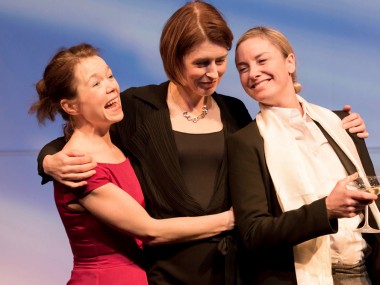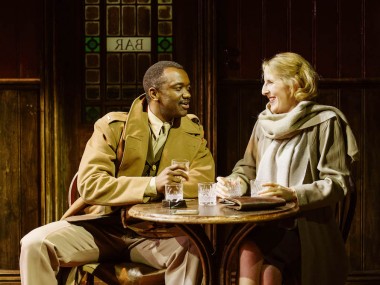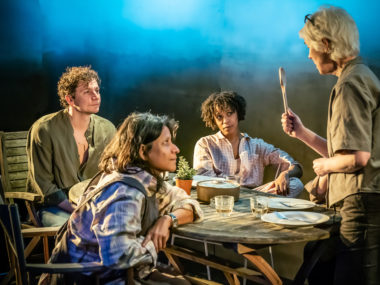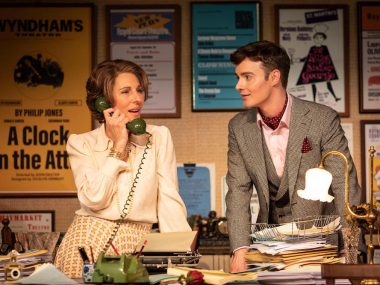The Divine Mrs S, Hampstead Theatre
Thursday 11th April 2024
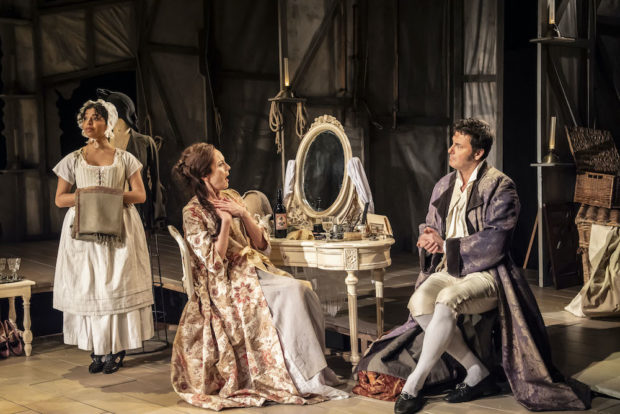
British theatre’s love of theatre about theatre offers a chance for some moments of meta, but do these kinds of play risk being rather complacent about the serious subjects they cover? April De Angelis’s latest comedy drama, The Divine Mrs S, is a history play that examines the life of Mrs Sarah Siddons, the star actress of the West End in the age of Jane Austen. Its premiere at the Hampstead Theatre stars Rachael Stirling, twice nominated for an Olivier Award, and Law & Order: UK’s Dominic Rowan. But what is this history play actually saying about the theatre and society in the Georgian age? And about our own times?
It’s 1800, and we are backstage at the Theatre Royal Drury Lane in the dressing room of the acclaimed Siddons, an actor whose USP is emotionality on stage. She has just come off in a faint because the part she is playing to packed houses — Mrs Halle in August von Kotzebue’s The Stranger — has been reunited with her lost children; to Siddons, who has just lost a child of her own, it’s all too much. But the crowd love it. And her violent feelings. Not so her brother, John Philip Kemble, a less talented actor but the theatre’s manager. Both Kemble and Siddons’s absent and cheating husband have the power over her career. They decide which parts she must play, where and when. Resentful of being forced to act soppy roles, Siddons is excited when an anonymous script about a strong woman arrives. But who wrote it, and how will Kemble react to it?
Being a feminist, and having previously explored women’s experiences in the backstage worlds of British theatre — in Playhouse Creatures (1993) and A Laughing Matter (2002) — De Angelis gives a highly sympathetic version of Siddons’s situation. She includes several other women in her plotting, from the star’s dresser and confidant Patti to Mrs Larpent, the wife of the theatre censor. The case of the Scottish woman playwright Joanna Baillie, whose play De Montford starred Siddons and Kemble, but was attacked when it became known that its creator was a woman, is central to a plot that asks how far it was possible in the late 18th century for women to give a voice to their true feelings, rather than articulating emotions and moral positions that were expected of them.
The answer is depressingly predictable, but absolutely true — not very far. The fact that Siddons finds that the availability of roles diminishes as she ages is only one of the modern parallels that leap off the stage. But De Angelis is interested in more than the sexism of the age of corsets and bonnets. She is also attuned to the difficulties of motherhood at a time of extreme infant mortality, and her sympathy towards Siddons’s losses also highlights the familiar story of balancing careers with childcare. The fact that Siddons has to mother not only her children, but submit to her brother and husband’s whims, and looking after battered male egos, once again has resonance with the experiences of women in today’s theatre.
The stature of the actress, who was lauded by critics and public, becoming the uncontested Queen of Drury Lane, reminds us that the age of modern celebrity has a long tailback. As a cultural superstar, Siddons enjoyed enormous attention, which meant that she had to tread very carefully, training herself to be manipulative in order to persuade the theatre censor, careful in order to avoid upsetting the critics, and — in addition to her onstage characters — performing the role of a respectable woman in daily life. In this play the short moment when Kemble threatens to assault Patti is a grim reminder of the dangers posed by the backstage space, both safely private for stars and unsafe for lesser unchaperoned women.
De Angelis’s account has a good handful of witty lines, and there is a light quality to the storytelling, which however sadly meanders a bit in the second half. Parallels with today’s actors are emphasized, as when Siddons gets letters of hate mail (comparisons with social media pile-ons are obvious). The jokes about actors, plays and critics are all rather goodnatured and entertaining, with some nice cracks in the fourth wall, but the feeling is that this is a rather soft and — dare I say? — superficial look at Siddons. For although she is on stage for most of the evening her character remains a bit elusive. Perhaps this is because De Angelis perceives that this actor’s life was such a performance that it is hard to get to grips with her real feelings — except for when she reminds Kemble of a childhood trauma.
The most difficult part of the play is the second act, where the plotting looks at another of Baillie’s plays, and Siddons is once again in discussions about licensing with Larpent. This time, however, I found it hard to follow the exact storyline because the issues — which involve Larpent’s daughter (a runaway from a violent husband) — were muddied by too much detail. At a crucial point the audience of the Theatre Royal Drury Lane threaten to burn down the build. But why? And who is the injured actor who wants a benefit performance as a kind of welfare payment, and what has he got to do with the story about theatre censorship? At this point, it really feels as if too much research material is undermining the drama.
Anna Mackmin’s production, on Lez Brotherston’s realistic set, gives some space to the plot’s darker moments, such as an infant death and a scene in an asylum where the rebellious wife has been confined by her husband, but the overall vibe is of a rather cheery account of patriarchy. Dominating the play is Stirling’s performance as the imperious, elegant and incisive Siddons, a woman who both indulges her deepest feelings and whose success is double-edged. Rowan has some good fun with Kemble’s onstage histrionics, and the rest of the men are colorfully caricatured: Gareth Snook plays the critic Boaden and the portrait painter Thomas Lawrence as well as a couple of other blokes. Anushka Chakravarti’s Patti, who hails from Barnsley, is a neat cameo while Eva Feiler and Sadie Shimmin give life to Baillie and Larpent, plus some others. But the general effect of the show is more mundane than divine.
© Aleks Sierz

